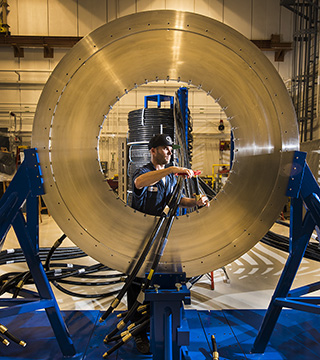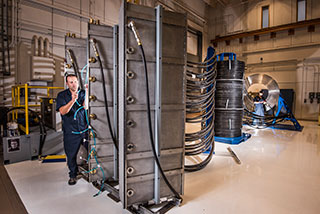Sophisticated machine will crush materials at 1 million atmospheres

MAKING READY FOR THOR — Sandia tech Eric Breden terminates a transmission cable for installation on the silver disk that is the new pulsed-power machine’s central powerflow assembly. (Photo by Randy Montoya)
A new star is rising in Area 4. Its name is Thor, its aim is to study materials at extreme pressures, and its novel features may foreshadow future renovations in Z, the world’s largest and most powerful pulsed-power accelerator.
Z is a mainstay in Sandia’s stockpile stewardship efforts. It is also Sandia’s lead machine in the race for peacetime nuclear fusion and premier in creating research conditions mimicking the cores of planets and interiors of stars.
The completed Thor will be smaller and less powerful than Z — 2,000 rather than 10,000 square feet, 100 kilojoules instead of 20 megajoules — but has improvements in design befitting a next-generation accelerator.
The immediate benefit of the new machine is that it will achieve up to five experiments daily, investigating materials by means of its electrically pulse-generated magnetic fields. This will reduce scheduling problems on overbooked Z, which currently can fire only once daily.
More opportunities to test ideas
“Thor will reach about one million atmospheres of pressure, far less than Z’s five million,” says David Reisman, the lead theoretical physicist of the Thor project, “but that’s still relevant. Earth’s core is at one million atmospheres, so Thor can perform many geophysics experiments.”
Furthermore, because Thor can fire so frequently — less hardware damage per shot requires fewer technicians and enables more rapid rebooting — researchers will have many more opportunities to test an idea, David says.
Thor also will be used develop experiments for Z, as well as a novel X-ray diagnostic that will probe the atomic structure of materials under extreme pressure. “It would be prohibitive to develop such an advanced diagnostic first on Z. Experiments there are fewer and much more expensive,” says David.
More at stake
But there’s more at stake here than rapidity of firing or even new diagnostics. There’s testing the efficiency of a radically different accelerator design.
Z’s design includes 36 massive capacitor banks called Marx generators (each is 8 ft. x 8 ft. in cross-section, 12 ft. tall). These release electrical energy through transmission lines as thick as a horse’s girth, followed by complicated switching to shorten its electrical pulse by an order of magnitude, from one microsecond to 100 nanoseconds. This temporal reduction is necessary to greatly increase the pulse’s impact on a target.
Thor ultimately will be built of much smaller but many more capacitors, segregated by twos in one-cubic-foot containers called bricks. Each capacitor pair will be combined with its own small switch that, when engaged, will immediately discharge current in a 100-nanosecond pulse, without the energy losses inevitable when compressing a long pulse. And each brick’s dedicated cables of far smaller diameters won’t need the expensive water and oil baths that shield Z’s massive current-bearing transmission lines from shorting out.
This change in design — from a few massive components to many small ones — could be considered analogous to the change in computing decades earlier that replaced a single, extremely powerful computer chip with many relatively simple computing chips working in unison, or, to the evolution of computers that replaced several high-voltage vacuum tubes with a much larger number of low-voltage solid-state switches.
Finer control of pulses
Among other advantages, the new architecture allows finer control of the electrical pulses sent to interrogate materials, similar to the way a pianist playing separate notes elicits a more satisfactory response from an audience than a single crash of chords. Says David, “Individual cables from each brick separate our signals. Then, by combining them in any manner we choose, we can tailor very precise current pulses.”

Tailored pulse shapes are needed to successfully interrogate a variety of materials to avoid shocks that would force them to change state. “We want the material to stay in its solid state as we pass through phase boundaries reached as pressures increase,” he says. “That way, we can more easily test the compressed matter. If we shock the material, it becomes a hot liquid and doesn’t give us information.”
Thor’s advantage over Z in such testing, says David, is that because each capacitor’s transit time is not only controllable to the nanosecond level but isolated from the other capacitors, “in relatively few seconds on a computer, we can determine the shape of the pulse that will produce a desired compression curve, whereas it takes days to determine how to create the ideal pulse shape for a Z experiment.”
There are other advantages to Thor’s architecture. Because current is subdivided among so many more units, Thor’s 200-kilovolt switches are expected to last for many thousands of shots, an order of magnitude larger than the life times of Z’s 6.6-megavolt switches, says senior manager Mike Cuneo.
Everything depends upon adding bricks. Thor, for which materials were assembled this year, is expected to achieve two intermediate stages in 2016. These will comprise 24 bricks (Thor 24) and 48 bricks (Thor 48). “These are ‘first-light’ machines that will be used for initial experiments and validation,” says David.
Could play a part in Z renovation
Then, due to more efficient switches and lesser interference from rebounding currents, Thor 144, when completed, is expected to be 40 times more efficient than Z in magnetically generated pressure. Technically, Thor 144 will achieve one megabar of pressure with 100 kiloJoules (which works out to 10 Mbar/MJ) while Z achieves 5 megabars with 20 MJ capacity (which works out to 0.25 Mbar/MJ).
Thus it’s not surprising that there’s thought that the new architecture may play a part when it comes time to renovate Z itself.
Thor’s bricks are a fourth-generation descendant of a device jointly developed by the Institute of High-Current Electronics (Tomsk, Russia) and Sandia called a linear transformer driver (LTD). The original LTD bricks had no cables to separate outputs, but instead were linked together to add voltage as well as current. (Because Thor’s bricks are isolated from each other, they add current but not voltage.)
High-yield fusion?
According to manager Bill Stygar, more powerful LTD versions of Z ultimately could bring about thermonuclear ignition and even high-yield fusion. Ignition would be achieved when the fusion target driven by the machine releases more energy in fusion than the electrical energy delivered by the machine to the target. High yield would be achieved when the fusion energy released exceeds the energy initially stored by the machine’s capacitors.
LTDs, says Mike Cuneo, “may be the simplest, most reliable, and efficient pulsed-power architectures to make plasmas that can potentially ignite and burn. We shouldn’t ever build a Marx generator-driven system again. That’s a 90-year-old technology.”
The academic community also is interested in Thor’s architecture. “Part of the motivation for Thor was to develop affordable and compact machines that could be operated at universities,” says David. Institutions that have expressed interest include Cornell University, University of California San Diego, Imperial College London, and the Carnegie Institution.
A paper published Sept. 9 in Physical Review Special Topics – Accelerators and Beams, co-authored by David, lead electrical engineer Brian Stoltzfus, Bill, lead mechanical engineer Kevin Austin, and colleagues, outlined Sandia’s plan for Thor. A later paper, led by Bill and in preparation for publishing in the same journal, discusses the possibility of building next-generation LTD-powered accelerators to achieve ignition and high-yield fusion.
Thor’s theoretical design was supported by Sandia’s Laboratory Directed Research and Development office; later engineering details and hardware by NNSA’s Science Campaign.